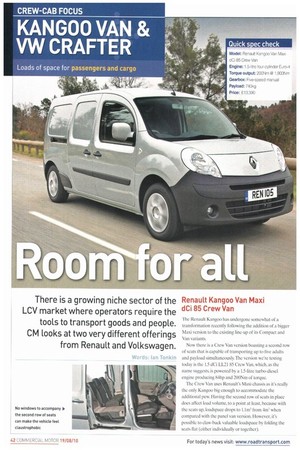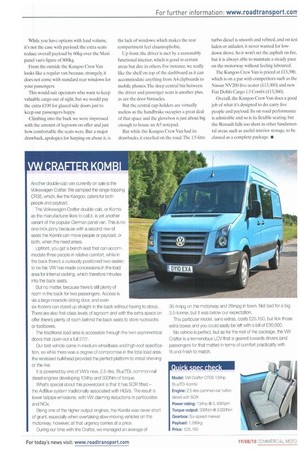There is a growing niche sector of the LCV market
Page 42

Page 43

If you've noticed an error in this article please click here to report it so we can fix it.
where operators require the tools to transport goods and people. CM looks at two very different offerings from Renault and Volkswagen.
Words: Ian Tonkin
Renault Kangoo Van Maxi dCi 85 Crew Van
The Renault Kangoo has undergone somewhat of a transformation recently following the addition of a bigger Maxi version to the existing line-up of its Compact and Van variants.
Now there is a Crew Van version boasting a second row of seats that is capable of transporting up to five adults and payload simultaneously. The version we're testing today is the 1.5 dCi LL21 85 Crew Van, which, as the name suggests, is powered by a 1.5-litre turbo-diesel engine producing 84hp and 200Nm of torque.
The Crew Van uses Renault's Maxi chassis as its really the only Kangoo big enough to accommodate the additional pew. Having the second row of seats in place does affect load volume, to a point at least, because with the seats up, loadspace drops to 1.1m% from 4rn when compared with the panel van version. However, it's possible to claw-back valuable loadspace by folding the ,eats fiat (either individually or together).
While you have options with load volume, it's not the case with payload: the extra seats reduce overall payload by 60kg over the Maxi panel van's figure of 800kg.
From the outside the Kangoo Crew Van looks like a regular van because, strangely, it does not come with standard rear windows for your passengers.
This would suit operators who want to keep valuable cargo out of sight. but we would pay the extra £100 for glazed side doors just to keep our passengers happy.
Climbing into the back we were impressed with the amount of legroom on offer and just how comfortable the seats were. But a major drawback, apologies for harping on about it, is the lack of windows, which makes the rear compartment feel claustrophobic.
Up front, the driver is met by a reasonably functional interior, which is good in certain areas but dire in others. For instance, we really like the shelf on top of the dashboard as it can accommodate anything from A4 clipboards to mobile phones The deep central bin between the driver and passenger seats is another plus, as are the door binnacles.
But the central cup-holders are virtually useless as the handbrake occupies a great deal of that space and the glovebox is just about big enough to house an AS notepad.
But while the Kangoo Crew Van had its drawbacks, it excelled on the road.The 1.5-litre turbo-diesel is smooth and refined, and on test laden or unladen, it never wanted for lowdown shove. So it won't set the asphalt on tire, but it is always able to maintain a steady pace on the motorway without feeling laboured.
The Kangoo Crew Van is priced at £13,390, which is on a par with competitors such as the Nissan NV200 five-seater (L13.300) and new Fiat Doblo Cargo 1.3 Combi (£13,360).
Overall. the Kangoo Crew Van does a good job of what it's designed to do: carry live people and payload. Its on-road performance is admirable and so is its flexible seating, but the Renault falls too short in other fundamental areas. such as useful interior storage, to be classed as a complete package. •




























































































































